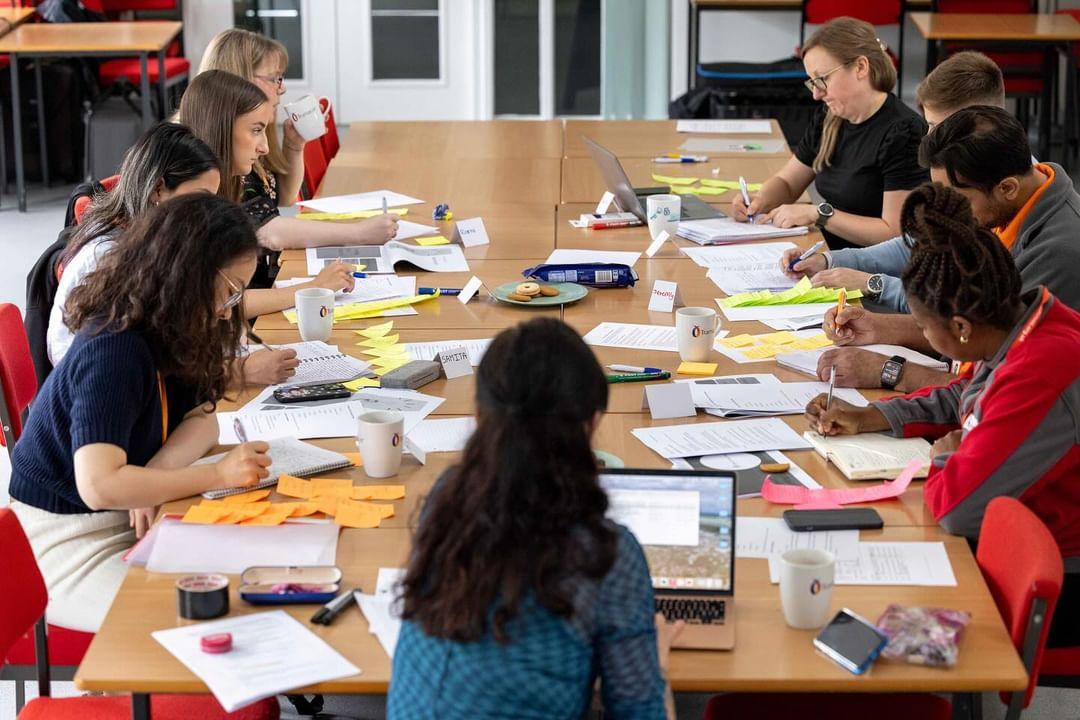News
News from SEGRO Logistics Park Radlett

We’ve launched a new Community Investment Plan to support people living in the communities around SEGRO Logistics Park Radlett.
The plan was developed and will be delivered in partnership with seven local community and education partners – Communities 1st, Emmaus, Mind in Herts, St Albans Foodbank, Citizens Advice Bureau, Oaklands College and SmallPeice Trust – to improve social inclusion and community wellbeing.
Over the next few years, we expect around 1,000 young people from local schools to take part in careers sessions, STEM workshops and skills-based activities. These will give students the chance to explore different career paths and learn more about opportunities in construction and logistics.
We’re also aiming to help 300 local people into work through targeted training. This includes confidence-building support, digital skills development and volunteering opportunities.
As part of the plan, we’re funding a new CSCS training centre at Oaklands College, which will enable more than 700 learners and adult jobseekers to gain essential construction qualifications.
In addition, over 300 residents will benefit from new wellbeing initiatives, including mental health and counselling support, nutrition workshops and services for those facing homelessness or food insecurity.
Stephen Craker, Chief Executive, Communities 1st, said: “SEGRO’s Community Investment Plan will enable the St Albans Community Partnership to extend practical help for those who will benefit from tailored training, structured pathways into work and wider wellbeing support.”
Chloe Hawkins, Director of Adult & Work Based Training, Oaklands College, said: “We’re delighted to partner with SEGRO on this initiative which will directly support our construction students and adult learners in a sector which is important to both our organisations.”
Four T-Level students from Oaklands College in St Albans have recently completed a nine-week work placement at SEGRO Logistics Park Radlett, gaining first-hand experience of what it’s like to work on one of the region’s most significant infrastructure projects
The students, studying Design, Surveying and Planning, spent time across several departments, learning about construction, engineering, health and safety and commercial operations. Their placements saw them working alongside experienced professionals from VolkerFitzpatrick, our contractor responsible for constructing the rail chord, and SEGRO, offering a valuable opportunity to see how theory meets practice on a major project.
Evie Clark-Harding, one of the students, said: “I've really enjoyed my time and grown personally. I've learned a lot from the Radlett team, from professional etiquette to onsite operations. I definitely plan to apply for future apprenticeships.”
Another student, Favour Neji, added: “I'm sincerely grateful to the Radlett Team for their support and guidance during this impactful placement. The skills I've gained have laid a strong foundation for my future in Civil Engineering and confirmed my decision to pursue a degree apprenticeship.”
This initiative forms part of the wider effort by SEGRO and its supply chain partners to create opportunities for local people to gain skills and experience in the construction and logistics sectors.

STRABAG UK, a subsidiary of the STRABAG Group, one of Europe’s leading construction companies, has been awarded the contract to deliver the next and final phase of infrastructure works at SEGRO Logistics Park Radlett.
Working in partnership with Enfield-based civil engineering firm, Galldris, and Huntingdon-based earthworks specialist Mick George Group, the contract covers the creation of the plots on which the rail terminal and warehouses will be built; the establishment of the bund surrounding the development plateau; the building of the private estate roads; and the construction of the rail terminal. Their work will also include a range of offsite highway improvements, such as junction upgrades on the A414 and M25, as well as a new link road bypassing Park Street and Frogmore.
STRABAG UK are committed to working with SEGRO and other delivery partners to ensure that the community are kept informed of key work activity that may impact them. The teams are in the process of site mobilisation and will commence work soon.
Between them, the companies have experience of working on a wide range of high profile and complex engineering projects, including HS2’s London Tunnels, Google’s new headquarters in Kings Cross and the HARP project for United Utilities.
Public exhibitions have taken place at Park Street Village Hall and Caledon Community Centre, London Colney during January to share information about SEGRO Logistics Park Radlett. Local residents, councillors and business owners attended over several days to learn more about the project and raise any questions they had with SEGRO representatives. We were pleased with the high level of engagement from the local community and to answer questions about the scheme and how it will be delivered. It was also a good opportunity to talk through common misconceptions and understand concerns that we can monitor and address going forward.
During the exhibition, we discussed a number of topics, including the construction schedule and what local people can expect during the works, how we will manage local roads and traffic during the construction phase and what the operation of a typical Strategic Rail Freight Interchange looks like. Additionally, we were happy to share details of our plans to invest in local initiatives as part of our wider community investment programme.
Following the exhibition, we will update the Q&A section of the website so everyone can see the responses to the key questions asked, and our Community Liaison Officer will continue to be available to liaise with members of the community on individual matters. Furthermore, the established Community Liaison Group, which is made up of representatives from Residents’ Associations, Parish Councils, District and County Councils from the surrounding communities, meets regularly to discuss the scheme.
The first major construction milestone at SEGRO Logistics Park Radlett was delivered successfully during the Christmas 2024 period with the installation of a vital underbridge beneath the Midland Main Line.
The new underbridge, installed over five days while the railway between London St Pancras and Bedford was already closed to replace a bridge in Camden and to upgrade overhead electric lines along the route, will allow the future rail freight terminal to connect directly to the national rail network.
The process involved cutting out a 60m section of track and removing approximately 12,500 m3 of material from the 19th century rail embankment, using hydraulic jacks to slide a 6,000-tonne pre-cast concrete structure into place at approximately four metres per hour, then re-filling the earth around the concrete structure and reinstating the track.
While this milestone is relatively small in the context of the wider development, it is vital to ensuring that the freight terminal will be capable of operating by the time the first building has been constructed and reinforces our commitment to rail freight being at the heart of this development.